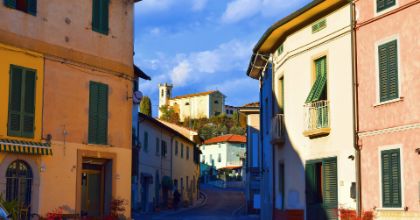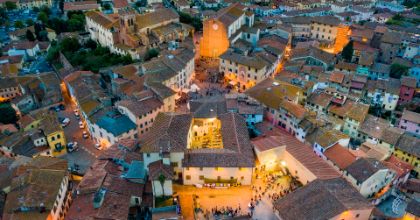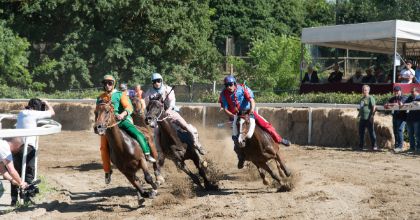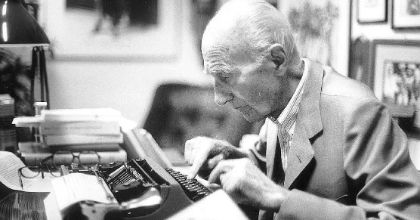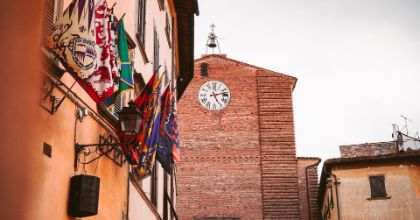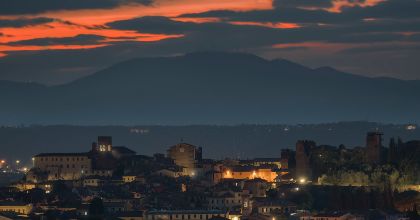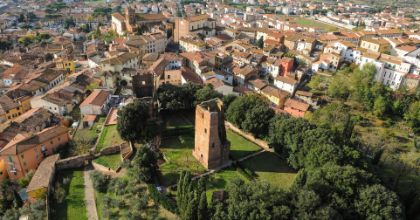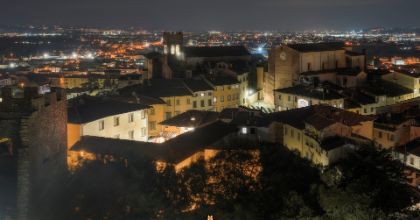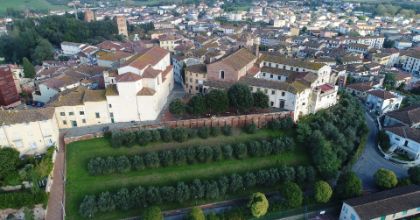Collegiate Church of San Giovanni Battista
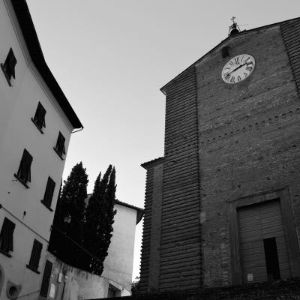
The Collegiate Church of Fucecchio, dedicated to Saint John the Baptist, is located in today’s Piazza Vittorio Veneto, on the site where the ancient parish church was built, established by the will of the Cadolingi counts. Already awarded the title of Collegiate, the old building was demolished at the end of the eighteenth century to make room for a new and larger building. The main entrance can be reached both from Poggio Salamartano and from Piazza Vittorio Veneto through a wide stone staircase.
Inside, the Collegiate Church has a magnificent neoclassical Latin cross with side chapels. At the same time the remarkable plastic decorations and most of the furnishings, such as - in the first chapel on the right - the canvas with "Madonna and Child and two Saints" by Gaspero Martellini, the "Martyrdom of Saint Lucia" and "Our Lady of the Rosary" by Pompeo Caccini, in the first chapel on the left - the "Madonna Enthroned with Child with Saints John the Baptist, Mark, Peter and Andrew".
Much venerated is the "Madonna di Piazza", marble high relief depicting the Virgin and Child. Originally located on the corner of the former Palazzo di Cancelleria (Piazza Vittorio Veneto), the image was, according to tradition, a protector during the plague of 1630, receiving a dark spot on his face.
Noteworthy are the frescoes by Antonio Domenico Gamberoni (1720) and Antonio Gajoni (1950-1960). Other tables of significant artistic interest are now kept in the nearby Civic Museum. Under the main altar there is, in carved and gilded wood, the reliquary urn of San Candido, work of the early nineteenth century, containing the remains of the patron saint of the town.
Church of San Salvatore
Founded by Count Cadolo at the bridge over the Arno, the Church of San Salvatore is remembered for the first time in a document of 986.
Flanked around the year 1000 by a Benedictine monastery, both buildings were rebuilt on a hill near the castle of Salamarzana (today’s Poggio Salamartano) following the disastrous flooding of the river in 1106. At the end of the thirteenth century, after the extinction of the Cadolingi family, the first period of considerable wealth was followed by the decline: entrusted to the Franciscans then passed to the Poor Clares who still reside there.
Outside, there are still visible elements dating back to the early medieval period, such as the small side arches or the remains of mullioned windows and terracotta arches decorated on the facade. The robust bell tower that rises on the back side is also attributable to the Middle Ages. Renovations and enlargement followed from the sixteenth to the eighteenth century have given the Church its current appearance.
Inside the church, with a single large nave according to the typical Franciscan scheme, stands out in Carrara marble the high altar, built in the first decade of the eighteenth century. Of the same period is the above painting on canvas of Christ on the cross with Madonna, Maddalena and San Giovanni. The side altars, of Vasari plant, were erected between the end of the XVI-th and the beginning of the XVII-th century, but they have undergone successive modifications. On the left side there is a wooden Crucifix of valuable quality of unknown master of the sixteenth-sixteenth century, object of particular veneration. Also on the left side a rare organ of 1626 by the masters Andrea and Cosimo Ravani from Lucca.
Church of the Virgin of Ferruzza
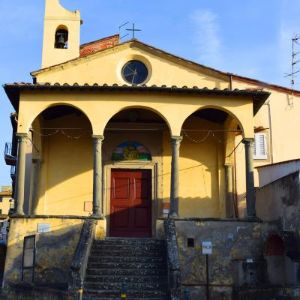
The charming oratory of the Virgin is located above the source called, from the late '400, Ferruccia, from which the modern location in Via della Ferruzza. The source was built by the City outside the Porta Nuova di Sant'Andrea by the will of the Podestà Antonio Ferrucci sent to Fucecchio by Lorenzo Il Magnifico in the March-September 1473. A tabernacle with the figure of the Virgin, also called Ferruccia, was built above the fountain.
On January 3, 1503, the eve of the feast of Saint Christian, according to documents, the Virgin began to perform miracles "ditti virgo incepit Facere miracula". From then on, an oratory was built around the image of the Virgin, called Church in 1533. In 1548 the day devoted to the Virgin Ferruccia became festive.
The church was under the patronage of the Municipality that long promoted its preservation until, in the late eighteenth century, it passed to the Chapter of the Collegiate Church of San Giovanni Battista by whose priests it is still officiated.
The exterior is preceded by a small but elegant loggia and a staircase that descends near the ancient sinks.
Inside the valuable fresco representing "Madonna and Child Enthroned, Saint John the Baptist and Saint Anthony the Abbot", executed in the summer of 1473, was recently attributed, through the documents of the Historical Archives of the Municipality of Fucecchio, to Filippino Lippi who was very young at the time. The work, which reproduces the styles of the schools of Filippo Lippi, father of Filippino, and Sandro Botticelli, disciple of his father and his teacher, was restored in 1946. Already in 1800 the fresco was attributed to the school of Filippo Lippi.
Before the restoration, only the figure of the Madonna and Child was visible because the Saints were framed in a painting depicting Saint John the Baptist and Saint Benedict, preserved in the Civic Museum.
Sanctuary of the Madonna delle Vedute
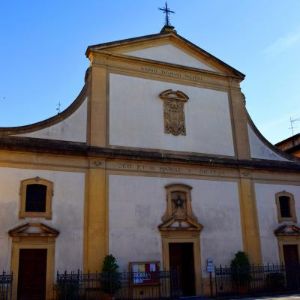
Built in the first half of 1700 to enlarge the oratory of San Rocco fuori le mura, the church is now located in Via Dante and takes its name from the image of the Madonna that was transferred in 1730 from "Le Vedute", in the woods of Cerbaie.
Placed on the high altar and repainted several times, the image is framed in a ''triumph' of angels and cherubim, a baroque work by an anonymous sculptor, who was inspired by the Bernini decoration of the Chair of Saint Peter. According to tradition the work was frescoed in the thirteenth century within a tabernacle erected to indicate the way to travelers. Various miracles have been attributed to the image, the object of popular veneration.
The facade acquired its current appearance in 1911 when it underwent a radical restoration. The central nave dates back to the mid-18th century, when the old oratory was radically renovated to house the image of the Madonna delle Vedute. The two side naves were added in the 19th century.
Church and Convent of the Virgin
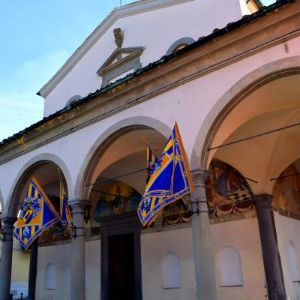
The church and the convent of the Virgin were built at the beginning of the seventeenth century in the place called ''alle Cinque Vie'', at the intersection of important roads of communication (today Piazza La Vergine). Here there was a small oratory where the "Society of Charity" brotherhood devoted to the Virgin Mary and her image. On the wave of a general devotion also favored by the Medici themselves, this managed to obtain the consent of the Grand Duke to erect a convent for the Franciscan Fathers and to rebuild, In 1631 the building was completed, although the works continued with the construction of the bell tower (1632), the cloister (1638-1660) and the cells for the friars.
On the facade, preceded by a portico with four lights, is visible at the top, above the window and the windows lobate, the Medici coat of arms.
Under the portico there are three lunettes and four niches with Via Crucis, the latter frescoed by Alberico Carlini, who also painted the cloister.
The interior has a single nave with side altars in stone of the seventeenth century. On the walls of the presbytery two paintings from the second half of the nineteenth century depicting the miracles attributed to San Teofilo, whose relics are preserved inside the church itself. In the choir with double-order stalls of 1691 there was transferred the organ made in 1825 by Benedetto Tronci of Pistoia.
The large cloister, adorned with twenty-four lunettes with stories of Saint Francis performed in the first half of the '700 by Father Alberico Carlini, has been the subject of a careful restoration that has led to the original appearance. On the wall to the right of the entrance the tomb of Giuseppe Montanelli, Tuscan triumvir and protagonist of the Risorgimento (1813-1862).
Sanctuary of Saint Mary at Querce
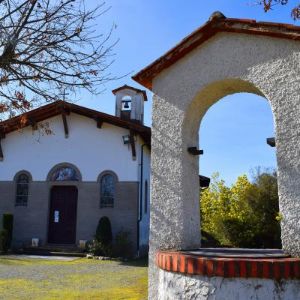
The history of the Sanctuary of Santa Maria alla Querce, located at the northern limit of the municipality of Fucecchio, in Via delle Cellina, has remote origins although today little known. Already in the Middle Ages there was a church, dedicated to the martyr Nazario, located lower than the current parish church, of which we can remember already from 866; but it is only at the beginning of the seventeenth century that this place, hidden in the woods of Cerbaie, lives a new season, becoming a place of Marian worship. An image on an oak tree and a source of water give rise to a story of faith that has survived to this day. But history was then superimposed on a legend and the Cellina, name of the small sanctuary built on the source, will become the place of apparition of the Madonna.
